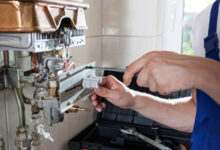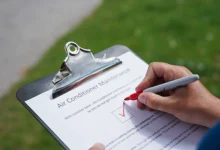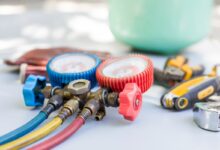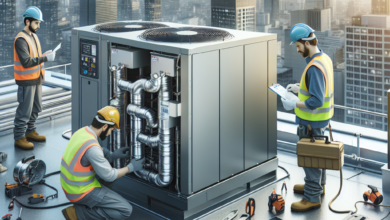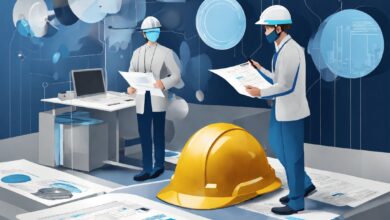HVAC Preventative Maintenance Checklist
HVAC Preventative Maintenance Checklist – As a homeowner or business owner, it’s crucial to ensure that your HVAC (Heating, Ventilation, and Air Conditioning) system is functioning optimally. Regular HVAC preventative maintenance can save you from costly repairs and extend the lifespan of your equipment. In this comprehensive guide, we will walk you through a step-by-step checklist to help you maintain your HVAC system’s efficiency and reliability.
Understanding the Importance of HVAC Preventative Maintenance
Proper HVAC preventative maintenance is more than just a routine task – it is a foundational step towards ensuring the longevity and efficiency of your heating and cooling system. By neglecting maintenance, you run the risk of decreased energy efficiency, increased energy costs, and even premature system failure. This section will delve into the importance of HVAC preventative maintenance, highlighting its benefits and why it should be a top priority for homeowners and businesses alike.
Improved Energy Efficiency
Regular HVAC maintenance plays a vital role in maximizing energy efficiency. When your system is clean and well-maintained, it operates smoothly, allowing it to achieve optimal performance while consuming less energy. As a result, you not only save on utility bills but also contribute to environmental conservation by reducing your carbon footprint.
One of the primary tasks in ensuring energy efficiency is cleaning or replacing air filters regularly. Clogged filters restrict airflow, forcing the system to work harder to maintain the desired temperature. By cleaning or replacing filters as recommended by the manufacturer, you can ensure proper airflow and prevent unnecessary strain on your HVAC system.
Enhanced Indoor Air Quality
Indoor air quality is a significant concern for both residential and commercial spaces. HVAC systems play a crucial role in maintaining healthy indoor air by circulating and filtering it. However, without regular maintenance, the quality of the air you breathe can be compromised.
During routine HVAC maintenance, cleaning and inspecting air ducts are essential tasks. Over time, dust, dirt, allergens, and even mold can accumulate in the ductwork, reducing the air quality. By cleaning the ducts, you remove these contaminants, ensuring that the air circulating in your home or office remains clean and healthy.
Increased System Lifespan
An HVAC system is a significant investment, and you want it to last as long as possible. Regular preventative maintenance is the key to increasing the lifespan of your equipment and avoiding premature breakdowns.
One critical aspect of increasing system lifespan is lubricating moving parts. The various components of your HVAC system, such as fan motors and bearings, require proper lubrication to minimize friction and wear. During maintenance, a qualified technician will lubricate these parts, ensuring smooth operation and reducing the risk of premature failure.
Furthermore, regular inspections can help identify and address minor issues before they escalate into major problems. Detecting and resolving issues early on can prevent extensive damage and costly repairs, ultimately prolonging the life of your HVAC system.
Monthly HVAC Maintenance Tasks
While annual and seasonal maintenance tasks are crucial, monthly HVAC maintenance plays an equally important role in keeping your system running efficiently. This section will outline the essential tasks that should be performed on a monthly basis to ensure optimal performance and prevent potential issues.
Check and Replace Air Filters
Checking and replacing air filters is perhaps one of the simplest yet most critical maintenance tasks for your HVAC system. Over time, filters become clogged with dust, pollen, and other airborne particles, hindering airflow and reducing system efficiency. It is recommended to check your air filters monthly and replace them when they become dirty or clogged.
When inspecting the filters, look for signs of excessive dirt or damage. If you have a reusable filter, clean it according to the manufacturer’s instructions. For disposable filters, replace them with new ones of the same size and type. Regularly changing or cleaning filters not only improves system performance but also enhances indoor air quality.
Inspect Thermostat Settings
Ensuring accurate thermostat settings is essential for maintaining a comfortable indoor environment and preventing unnecessary energy consumption. Monthly thermostat inspection allows you to verify that the settings align with your desired temperature and that the system is functioning correctly.
Check that your thermostat is set to the appropriate mode (heating or cooling) and that the temperature is at the desired level. If your thermostat is programmable, review and adjust the programmed settings if necessary. Additionally, inspect the thermostat for any signs of damage or malfunction, such as unresponsive buttons or flickering displays. A malfunctioning thermostat can lead to inconsistent temperatures and increased energy usage.
Clean and Clear Vents and Registers
Vents and registers play a crucial role in distributing conditioned air throughout your home or office. Over time, they can accumulate dust, dirt, and obstructions, hindering proper airflow and reducing system efficiency. Monthly cleaning and clearing of vents and registers can help maintain optimal performance.
Start by removing any objects or furniture that may be blocking the vents. Then, using a vacuum cleaner or a soft brush, gently clean the vent grilles to remove dust and debris. Be thorough in your cleaning to ensure maximum airflow. If you notice any damaged or loose vent covers, consider replacing or repairing them to avoid air leakage.
Inspect and Clean Condensate Drain Lines
Condensate drain lines are responsible for removing excess moisture produced by your HVAC system. Over time, these drain lines can become clogged with algae, mold, or debris, leading to water leaks and potential damage. Monthly inspection and cleaning of the condensate drain lines help prevent such issues.
Locate the condensate drain line, typically found near the indoor HVAC unit. Inspect the line for any signs of clogs, such as water pooling or slow drainage. If you notice a clog, you can use a mixture of water and bleach to flush the line and remove any blockages. However, if you are unsure or uncomfortable performing this task, it is advisable to seek professional assistance.
Test and Clean Humidifiers (If Applicable)
If your HVAC system includes a humidifier, it is crucial to test and clean it regularly to ensure proper functioning and avoid potential issues. Humidifiers help maintain optimal humidity levels in your indoor environment, preventing dryness that can lead to discomfort and health problems.
Refer to the manufacturer’s instructions for testing and cleaning your specific humidifier model. This typically involves checking the water supply, cleaning or replacing the humidifier pad or filter, and inspecting for any signs of damage or leaks. Proper maintenance of humidifiers helps prolong their lifespan and ensures the delivery of clean and adequately humidified air.
Inspect Outdoor Unit for Debris
If your HVAC system has an outdoor unit, it is susceptible to debris buildup, which can obstruct airflow and hinder system performance. Monthly inspection and cleaning of the outdoor unit are essential for maintaining optimal efficiency.
Start by visually inspecting the unit for any visible debris, such as leaves, dirt, or grass clippings. Carefully remove any debris that may have accumulated on or around the unit, taking care not to damage any delicate components. Additionally, ensure that the area around the unit is clear, allowing for sufficient airflow. If necessary, gently hose down the unit to remove dirt or grime.
Check for Unusual Noises or Odors
Unusual noises or odors coming from your HVAC system can be indicators of underlying issues that require attention. As part of your monthly maintenance routine, take the time to listen for any unusual sounds or detect any strange odors.
Listen for any clanking, banging, hissing, or grinding noises. These can indicate problems such as loose components, motor issues, or refrigerant leaks. Similarly, be aware of any unusual smells, such as burning odors or musty/moldy scents, which may suggest electrical problems or mold growth. If you notice any concerning noises or odors, it is advisable to contact a qualified HVAC technician for further inspection and resolution.
Review Energy Bills
Monitoring your energy bills can provide valuable insights into the performance and efficiency of your HVAC system. By reviewing your monthly energy bills, you can identify any sudden increases in energy consumption, which may be a sign of underlying issues or inefficiencies.
Compare your current energy bills with historical data to detect any significant deviations. If you notice a substantial increase in energy usage without a justifiable explanation, it may be time to investigate further. Factors such as dirty filters, malfunctioning thermostats, or aging equipment can contribute to increased energy consumption. Addressing these issues promptly can help restore energy efficiency and prevent unnecessary costs.
Document and Track Maintenance
Maintaining a record of your HVAC maintenance activities is essential for tracking your system’s performance, identifying recurring issues, and ensuring consistent upkeep. Create a maintenance log where you can document each monthly maintenance task performed along with the date.
Include details such as filter changes, thermostat adjustments, and any observations or concerns noted during your inspections. This log serves as a valuable reference and can help you identify patterns or trends in system performance. Additionally, it can provide crucial information for future discussions with HVAC technicians, allowing them to have a comprehensive understanding of your system’s maintenance history.
Schedule Professional Maintenance
While monthly maintenance tasks can be performed by homeowners, it is crucial toschedule professional HVAC maintenance at regular intervals. Professional maintenance ensures a thorough inspection of your system and the identification of any underlying issues that may not be apparent during your monthly maintenance routine. It is recommended to schedule professional maintenance at least once a year or as per the manufacturer’s guidelines.
During a professional maintenance visit, an HVAC technician will conduct a comprehensive check of your entire system, including components such as the furnace, air conditioner, heat pump, and ductwork. They will inspect electrical connections, test safety controls, measure refrigerant levels, clean coils, and perform any necessary adjustments or repairs.
Professional maintenance visits provide several benefits beyond what you can achieve through your own monthly maintenance tasks. Technicians have specialized knowledge and equipment to detect and resolve issues that may not be apparent to an untrained eye. They can also provide expert advice on optimizing system performance and efficiency.
Seasonal HVAC Maintenance Tasks
Seasonal maintenance plays a crucial role in preparing your HVAC system for the specific demands of each season. By addressing seasonal maintenance tasks, you can ensure optimal performance, energy efficiency, and comfort throughout the year. This section will outline the essential maintenance tasks to perform during each season.
Spring HVAC Maintenance
As winter transitions into spring, it is the perfect time to address maintenance tasks that prepare your HVAC system for the warmer months ahead. Spring maintenance focuses on cleaning, inspecting, and testing various components to ensure smooth operation.
Clean Outdoor Unit and Surrounding Area
Start by cleaning the outdoor unit and the area surrounding it. Remove any debris that may have accumulated during the winter, such as leaves, twigs, or dirt. Clear away any vegetation or obstructions that may hinder airflow. A clean and unobstructed outdoor unit allows for efficient heat exchange and prevents potential issues.
Inspect and Clean Indoor Evaporator Coils
Indoor evaporator coils play a crucial role in cooling your indoor space. Over time, these coils can accumulate dust and dirt, hindering heat transfer and reducing cooling efficiency. Inspect the indoor evaporator coils and clean them if necessary. Use a soft brush or a vacuum cleaner with a brush attachment to remove any debris gently.
Check Refrigerant Levels
Proper refrigerant levels are essential for efficient cooling. Insufficient or excessive refrigerant can affect system performance and lead to increased energy consumption. During spring maintenance, have a qualified technician check the refrigerant levels and adjust them if needed. This ensures optimal cooling efficiency and prevents potential damage to the compressor.
Inspect and Clean Air Ducts
Air ducts distribute conditioned air throughout your home or office. Over time, dust, dirt, and debris can accumulate in the ductwork, hindering airflow and reducing indoor air quality. Spring is an ideal time to inspect and clean the air ducts.
Consider hiring a professional duct cleaning service to thoroughly clean the ductwork and remove any contaminants. This helps maintain proper airflow, prevent system strain, and improve indoor air quality. Additionally, inspect the ductwork for any signs of damage or leaks and address them promptly.
Test Thermostat and Programmable Settings
Spring maintenance is an excellent opportunity to test your thermostat and review the programmed settings. Verify that the thermostat is functioning correctly and responds accurately to temperature adjustments. If you have a programmable thermostat, review and update the settings according to your springtime cooling needs.
Inspect and Clean Condensate Drain Lines
Condensate drain lines are prone to clogs and blockages, especially after a long heating season. Inspect the condensate drain lines and flush them with a mixture of water and bleach to remove any accumulated debris or algae. This ensures proper drainage and prevents potential water leaks.
Test and Clean Humidifiers (If Applicable)
If your HVAC system includes a humidifier, spring maintenance is an ideal time to test and clean it. Ensure that the humidifier is functioning correctly and delivering the desired level of humidity. Clean or replace the humidifier pad or filter, and inspect for any signs of damage or leaks. Proper maintenance of humidifiers ensures optimal performance and prevents issues related to excessive or inadequate humidity.
Summer HVAC Maintenance
Summer brings soaring temperatures and increased reliance on your air conditioning system. Proper summer maintenance helps ensure that your HVAC system can handle the demands of hot weather and keep your indoor space cool and comfortable.
Clean or Replace Air Filters
With increased cooling demands during the summer, it is crucial to keep your air filters clean and free of debris. Clogged filters restrict airflow, reducing cooling efficiency and increasing energy consumption. Check your air filters regularly and clean or replace them as needed.
Inspect and Clean Outdoor Unit
Since the outdoor unit is continuously exposed to the elements, it is susceptible to dust, dirt, and debris accumulation. Inspect the outdoor unit and clean it thoroughly to remove any obstructions. Use a soft brush or a vacuum cleaner with a brush attachment to clean the fins and coils. Clear away any vegetation or debris around the unit to ensure proper airflow.
Check Thermostat Calibration
As the temperatures rise during summer, accurate thermostat calibration becomes even more critical. Verify that your thermostat is calibrated correctly and accurately reflects the indoor temperature. If necessary, recalibrate the thermostat or consider upgrading to a programmable or smart thermostat for enhanced precision and energy efficiency.
Inspect and Clean Condensate Drain Lines
Summer humidity levels can put additional strain on your HVAC system’s condensate drain lines. Inspect the drain lines for any signs of clogs or blockages. Flush the lines with a mixture of water and bleach to remove any accumulated debris or algae. Proper maintenance of condensate drain lines prevents water leaks and potential water damage.
Test and Inspect Electrical Connections
Electrical connections play a crucial role in the safe and efficient operation of your HVAC system. Over time, connections can become loose or corroded, leading to electrical issues or system malfunctions. During summer maintenance, test and inspect electrical connections, ensuring they are secure and free of any signs of damage or wear.
Inspect and Clean Vents and Registers
Proper airflow is essential for cooling efficiency during the summer months. Inspect and clean vents and registers to ensure unrestricted airflow. Remove any dust or debris using a soft brush or a vacuum cleaner with a brush attachment. Ensure that the vents and registers are not obstructed by furniture or other objects that may impede airflow.
Fall HVAC Maintenance
As summer fades and the weather starts to cool, it is time to prepare your HVAC system for the upcoming heating season. Fall maintenance focuses on inspecting, cleaning, and testing various components to ensure optimal performance during the colder months.
Clean or Replace Air Filters
As you transition from cooling to heating, it is essential to start with clean air filters. Clogged filters restrict airflow, reducing heating efficiency and increasing energy consumption. Check your air filters and clean or replace them as needed to ensure proper airflow and prevent strain on the system.
Inspect and Clean Indoor Components
During fall maintenance, inspect and clean indoor components such as the furnace and blower motor. Remove any dust or debris that may have accumulated over the summer months. Inspect the furnace for signs of wear or damage, such as cracked heat exchangers or loose electrical connections. Address any issues promptly to ensure safe and efficient heating.
Check Thermostat Settings and Programming
Review and adjust thermostat settings and programming to align with your heating needs for the fall and winter seasons. Verify that the thermostat is functioning correctly and accurately reflects the desired indoor temperature. Adjust the programming to optimize energy efficiency and comfort based on your occupancy patterns.
Inspect and Clean Outdoor Unit
As the heating season approaches, it is crucial to inspect and clean the outdoor unit. Remove any debris that may have accumulated during the fall, such as leaves or branches. Clear away any vegetation or obstructions that may hinder airflow. A clean and unobstructed outdoor unit allows for efficient heat exchange and prevents potential issues.
Test and Inspect Ignition and Pilot Light
For systems with gas furnaces, fall maintenance includes testing and inspecting the ignition system and pilot light. Ensure that the ignition system is functioning correctly and that the pilot light ignites and remains lit. If you notice any issues, such as a weak flame or difficulty igniting, it is advisable to contact a qualified technician for further inspection and resolution.
Inspect and Clean Ductwork
Before the heating season begins, inspect the ductwork for any signs of damage or leaks. Damaged or leaking ducts can result in heat loss, reduced comfort, and increased energy consumption. Seal any visible leaks using appropriate duct sealant or contact a professional duct sealing service for a more comprehensive inspection and repair.
Test Carbon Monoxide Detectors
Carbon monoxide is a colorless and odorless gas that can be produced by malfunctioning heating systems. Fall maintenance is an ideal time to test carbon monoxide detectors and ensure they are functioning correctly. Replace batteries if needed and ensure that detectors are strategically placed throughout your home or office.
Winter HVAC Maintenance
Winter is the season when your HVAC system works the hardest to keep your indoor space warm and comfortable. Proper winter maintenance ensures that your system operates efficiently and reliably, even in the coldest temperatures.
Check and Replace Air Filters
With increased indoor heating during winter, it is crucial to maintain clean air filters for optimal system performance. Clogged filters restrict airflow, reducing heating efficiency and increasing energy consumption. Check your air filters regularly and clean or replace them as needed to ensure proper airflow and prevent strain on the system.
Inspect and Clean Indoor Components
During winter maintenance, inspect and clean indoor components such as the furnace, heat pump, or boiler. Remove any dust or debris that may have accumulated. Inspect the components for signs of wear or damage and address any issues promptly to ensure safe and efficient heating.
Test and Inspect Ignition and Pilot Light
For systems with gas furnaces or boilers, winter maintenance includes testing and inspecting the ignition system and pilot light. Ensure that the ignition system is functioning correctly and that the pilot light ignites and remains lit. If you notice any issues, such as a weak flame or difficulty igniting, it is advisable to contact a qualified technician for further inspection and resolution.
Monitor Heating Performance and Indoor Comfort
During the winter months, pay close attention to the performance of your heating system and the comfort level in your indoor space. Monitor the temperature and ensure that it remains consistent and comfortable throughout your home or office. If you notice any significant temperature variations or inadequate heating, it may indicate a problem with your HVAC system that requires professional attention.
Check and Adjust Thermostat Settings
Review and adjust your thermostat settings to optimize energy efficiency and comfort during the winter season. Consider adjusting the temperature settings based on your occupancy patterns and preferences. If you have a programmable or smart thermostat, take advantage of its features to create heating schedules that align with your daily routines.
Inspect and Clean Vents and Registers
Proper airflow is crucial for efficient heating during the winter. Inspect and clean vents and registers to ensure unrestricted airflow. Remove any dust or debris using a soft brush or a vacuum cleaner with a brush attachment. Ensure that the vents and registers are not obstructed by furniture or other objects that may impede airflow.
Monitor Humidity Levels
Winter often brings dry air, which can impact both your comfort and the health of your indoor environment. Monitor the humidity levels in your home or office and consider using a humidifier to maintain optimal humidity levels. Proper humidity helps prevent dryness and related issues such as dry skin, nasal congestion, and static electricity.
Inspect and Clean Outdoor Unit
While the outdoor unit may not be actively used during winter, it is still essential to inspect and clean it periodically. Remove any debris that may have accumulated, such as leaves or snow. Clear away any obstructions that may hinder airflow. A clean and unobstructed outdoor unit ensures proper functioning and prevents potential issues when the warmer seasons return.
Monitor Energy Consumption
Winter often brings increased energy consumption due to heating demands. Monitor your energy usage and compare it to previous winter seasons. If you notice a significant increase in energy consumption without a justifiable explanation, it may indicate inefficiencies or underlying issues with your HVAC system. Address any concerns promptly to restore energy efficiency and prevent unnecessary costs.
Annual HVAC Maintenance Tasks
In addition to monthly and seasonal maintenance tasks, annual maintenance is crucial for the long-term performance and reliability of your HVAC system. Annual maintenance tasks are typically more in-depth and may require the expertise of a qualified HVAC technician. This section will outline the essential tasks to perform on an annual basis.
Schedule Professional HVAC Inspection and Maintenance
Annual professional HVAC inspection and maintenance should be a top priority for homeowners and businesses. Hiring a qualified technician ensures a comprehensive assessment of your entire HVAC system and addresses any underlying issues that may affect performance and efficiency.
During the inspection, the technician will examine all components of your system, including the furnace, air conditioner, heat pump, ductwork, and electrical connections. They will clean or replace air filters, lubricate moving parts, test and calibrate thermostats, measure refrigerant levels, inspect electrical connections, and perform any necessary repairs or adjustments.
Professional HVAC maintenance not only ensures optimal performance but also helps identify potential problems before they escalate into major issues. By addressing minor concerns early on, you can avoid costly repairs and extend the lifespan of your HVAC system.
Clean and Inspect Ductwork
Annual cleaning and inspection of ductwork help maintain proper airflow and prevent energy loss. Over time, dust, debris, and even mold can accumulate in the ducts, reducing system efficiency and indoor air quality. Cleaning the ductwork removes these contaminants and ensures optimal airflow throughout your home or office.
Consider hiring a professional duct cleaning service to thoroughly clean the ductwork and remove any accumulated debris. Additionally, inspect the ductwork for any signs of damage or leaks. Damaged or leaking ducts can result in energy loss, reduced comfort, and increased energy consumption. Seal any visible leaks using appropriate duct sealant or contact a professional duct sealing service for a more comprehensive inspection and repair.
Test and Calibrate Thermostats
Annual testing and calibration of thermostats are essential for accurate temperature control and energy efficiency. Over time, thermostats may become less accurate, leading to inconsistent temperatures and increased energy consumption.
Verify that your thermostats are functioning correctly and responding accurately to temperature adjustments. Test their accuracy by comparing the displayed temperature with a reliable thermometer. If necessary, recalibrate the thermostats or consider upgrading to programmable or smart thermostats for enhanced precision and energy efficiency.
Inspect and Clean Outdoor Unit
Annual inspection and cleaning of the outdoor unit are essential for optimal performance and longevity. The outdoor unit is exposed to the elements throughout the year, making it susceptible to debris buildup and potential damage.
Inspect the outdoor unit for any signs of damage, such as bent fins or loose components. Clean the unit thoroughly, removing any debris, leaves, or dirt that may have accumulated. Clear away any vegetation or obstructions that may hinder airflow. A clean and unobstructed outdoor unit allows for efficient heat exchange and prevents potential issues.
Check and Adjust Refrigerant Levels
Proper refrigerant levels are essential for efficient cooling and heating. Annual inspection and adjustment of refrigerant levels help ensure optimal system performance and prevent potential damage to the compressor.
Have a qualified HVAC technician check the refrigerant levels and adjust them if needed. They will measure the refrigerant levels and compare them to the manufacturer’s specifications. If the levels are low, they will add refrigerant as necessary. Proper refrigerant levels are crucial for efficient operation and prevent strain on the system.
Inspect Electrical Connections
Annual inspection of electrical connections is essential for safe and reliable operation. Over time, electrical connections can become loose or corroded, leading to electrical issues or system malfunctions.
During the inspection, a qualified technician will examine all electrical connections, ensuring they are secure and free of any signs of damage or wear. Loose or damaged connections can lead to system inefficiencies, increased energy consumption, or even safety hazards. Address any concerns promptly to ensure the safe and efficient operation of your HVAC system.
Test Safety Controls
Safety controls are crucial components of your HVAC system, ensuring the protection of your home or office and its occupants. Annual testing of safety controls helps identify any malfunctions or issues that may compromise system safety.
A qualified technician will test various safety controls, such as pressure switches, limit switches, and flame sensors. They will verify that these controls are functioning correctly and responding appropriately to potential safety hazards. Testing safety controls is a critical step in preventing system malfunctions, fire hazards, or carbon monoxide leaks.
Lubricate Moving Parts
Moving parts within your HVAC system require proper lubrication to minimize friction and wear. Annual lubrication of these components helps ensure smooth operation and extends their lifespan.
A qualified technician will lubricate various moving parts, such as fan motors, bearings, and pulleys. They will use appropriate lubricants and follow manufacturer recommendations for each component. Proper lubrication reduces friction, minimizes energy consumption, and prevents premature failure of these critical components.
Inspect and Clean Coils
Coils, such as evaporator coils and condenser coils, play a crucial role in heat transfer and system efficiency. Over time, these coils can accumulate dust, dirt, and debris, hindering their performance and reducing overall system efficiency.
During annual maintenance, a qualified technician will inspect and clean the coils. They will use appropriate cleaning methods and products to remove any accumulated debris gently. Clean coils allow for optimal heat transfer, improved energy efficiency, and enhanced system performance.
Test and Verify System Performance
After completing all necessary maintenance tasks, it is crucial to test and verify the overall performance of your HVAC system. This includes testing temperature differentials, airflow, and system cycling.
A qualified technician will measure the temperature differentials between the supply and return air to ensure that the system is heating or cooling effectively.They will also assess airflow throughout the system, ensuring that it is balanced and reaching all areas of your home or office. Additionally, they will test the system’s cycling, ensuring that it turns on and off as expected and maintains consistent temperature control.
By testing and verifying system performance, any remaining issues or inefficiencies can be identified and addressed promptly. This final step in annual maintenance ensures that your HVAC system is operating at its best and providing optimal comfort and energy efficiency.
Troubleshooting and Common HVAC Problems
Even with regular maintenance, HVAC systems can encounter issues or problems. Understanding common problems and their potential causes can help you troubleshoot and address these issues effectively. This section will explore some common HVAC problems and provide troubleshooting tips to help you resolve them.
Inadequate Cooling or Heating
If your HVAC system is not providing sufficient cooling or heating, several factors could be contributing to the issue. Here are some troubleshooting tips:
Check Air Filters:
Clogged or dirty air filters can restrict airflow and reduce system efficiency. Check and clean or replace the filters as needed.
Inspect Thermostat Settings:
Verify that the thermostat is set to the desired temperature and mode (cooling or heating). Adjust settings if necessary and ensure that the thermostat is functioning correctly.
Check for Obstructed Vents:
Blocked or closed vents can impede airflow and prevent proper cooling or heating. Ensure that all vents are open and unobstructed.
Inspect Outdoor Unit:
If you have a central air conditioning system, check the outdoor unit for any signs of damage or debris accumulation. Clean the unit and ensure that it is receiving sufficient airflow.
Verify Ductwork Integrity:
Damaged or leaking ductwork can result in reduced airflow and uneven heating or cooling. Inspect the ductwork for any visible leaks or damage and address them promptly.
Strange Noises or Vibrations
If your HVAC system is producing unusual noises or vibrations, it may indicate underlying issues. Here are some troubleshooting tips:
Check for Loose Components:
Inspect the system for any loose components, such as fan blades, screws, or panels. Tighten any loose parts to eliminate vibrations or rattling noises.
Clear Debris from Outdoor Unit:
Debris, such as leaves or sticks, can get trapped in the outdoor unit and cause strange noises. Clear away any debris and ensure that the unit is clean and unobstructed.
Inspect Fan Motor:
A malfunctioning or worn-out fan motor can produce unusual noises. If you suspect an issue with the fan motor, contact a qualified technician for further inspection and repair.
Check for Refrigerant Leaks:
Refrigerant leaks can cause hissing or bubbling sounds. If you suspect a refrigerant leak, contact a qualified technician to identify and repair the leak and recharge the refrigerant as needed.
Inspect Ductwork:
Loose or improperly sealed ductwork can result in rattling or banging noises. Inspect the ductwork for any signs of damage or loose connections and address them promptly.
Poor Indoor Air Quality
If you are experiencing issues with indoor air quality, there may be several factors contributing to the problem. Here are some troubleshooting tips:
Clean or Replace Air Filters:
Clogged or dirty air filters can contribute to poor indoor air quality. Clean or replace the filters as recommended by the manufacturer.
Inspect and Clean Ductwork:
Dust, dirt, and debris can accumulate in the ductwork, affecting indoor air quality. Consider hiring a professional duct cleaning service to thoroughly clean the ducts and remove any contaminants.
Control Humidity Levels:
Excessive humidity can promote mold and mildew growth, while low humidity can cause dryness and discomfort. Use a dehumidifier or humidifier as needed to maintain optimal humidity levels.
Address Mold or Mildew:
If you suspect mold or mildew growth, particularly in the ductwork or other hidden areas, contact a professional mold remediation service to assess and address the issue.
Ensure Proper Ventilation:
Poor ventilation can contribute to stagnant air and poor indoor air quality. Ensure that your HVAC system is providing adequate ventilation and consider additional ventilation solutions if needed.
Uneven Heating or Cooling
If your HVAC system is providing uneven heating or cooling throughout your home or office, there may be underlying issues that need to be addressed. Here are some troubleshooting tips:
Inspect and Clean Vents:
Blocked or closed vents can restrict airflow and result in uneven heating or cooling. Ensure that all vents are open and unobstructed.
Balance Airflow:
If certain areas are receiving more airflow than others, you may need to balance the airflow by adjusting dampers or registers. Consult with a qualified technician for guidance on balancing airflow.
Check for Ductwork Leaks:
Leaking ductwork can result in uneven airflow and temperature distribution. Inspect the ductwork for any visible leaks and address them promptly to ensure consistent heating or cooling.
Verify Thermostat Calibration:
Ensure that your thermostat is accurately calibrated and reflects the desired temperature. Recalibrate if necessary or consider upgrading to a more precise thermostat.
System Not Turning On
If your HVAC system fails to turn on, there may be various reasons behind the issue. Here are some troubleshooting tips:
Check Power Supply:
Ensure that the HVAC system is receiving power. Check circuit breakers and ensure that they are not tripped. If the system is plugged into an outlet, verify that the outlet has power.
Inspect Thermostat:
Verify that the thermostat is functioning correctly and set to the appropriate mode (cooling or heating) and temperature. Replace batteries if necessary.
Test Safety Controls:
Safety controls, such as pressure switches or limit switches, can prevent the system from turning on if there is a safety concern. Test these controls and ensure that they are functioning correctly.
Verify Pilot Light or Ignition:
If you have a gas furnace or boiler, check the pilot light or ignition system. Ensure that the pilot light is on or that the ignition system is functioning correctly.
Inspect Electrical Connections:
Loose or damaged electrical connections can prevent the system from turning on. Inspect all electrical connections and address any issues promptly.
When to Seek Professional Help
While some HVAC issues can be resolved through troubleshooting and basic maintenance, certain problems require professional expertise. It is advisable to seek professional help in the following situations:
- If you are unsure about performing any maintenance or troubleshooting tasks.
- If you encounter complex or recurring issues that you are unable to resolve on your own.
- If your HVAC system requires repairs or replacements of major components.
- If you suspect refrigerant leaks or require refrigerant recharging.
- If you notice unusual odors, such as burning smells or strong chemical scents.
- If you experience electrical issues or concerns.
- If you suspect mold or mildew growth in the ductwork or other hidden areas.
Professional HVAC technicians have the knowledge, experience, and tools to diagnose and resolve complex issues. They can also provide expert advice on system maintenance, efficiency improvements, and potential upgrades. Contact a reputable HVAC service provider to schedule a professional inspection or repair when needed.
DIY vs. Professional HVAC Maintenance
When it comes to HVAC maintenance, there are tasks that you can perform yourself and others that require professional expertise. Understanding the difference between DIY maintenance and professional maintenance can help you make informed decisions and ensure the optimal performance of your HVAC system.
DIY Maintenance
DIY maintenance tasks are those that can be performed by homeowners or individuals with basic knowledge and skills. These tasks focus on regular cleaning, inspection, and minor adjustments. Here are some examples of DIY maintenance tasks:
- Checking and replacing air filters
- Inspecting and cleaning vents and registers
- Testing and adjusting thermostat settings
- Inspecting the outdoor unit for debris
- Testing and cleaning humidifiers (if applicable)
- Inspecting and cleaning condensate drain lines
- Monitoring energy bills and tracking maintenance activities
DIY maintenance tasks are relatively simple and do not require specialized tools or technical expertise. Performing these tasks regularly helps maintain the efficiency and reliability of your HVAC system. However, it is essential to follow manufacturer guidelines and safety precautions when performing DIY maintenance.
Professional Maintenance
Professional HVACmaintenance tasks go beyond the scope of DIY maintenance and require the expertise of qualified technicians. These tasks involve in-depth inspections, complex repairs, and specialized equipment. Here are some examples of professional maintenance tasks:
- Comprehensive system inspections
- Lubricating moving parts
- Testing and calibrating thermostats
- Measuring and adjusting refrigerant levels
- Cleaning and servicing coils
- Inspecting and repairing electrical connections
- Testing safety controls
- Inspecting and repairing ductwork
- Performing combustion analysis (for gas systems)
- Addressing complex issues and repairs
Professional maintenance tasks require specialized knowledge, experience, and equipment to ensure accurate and thorough assessments of your HVAC system. HVAC technicians are trained to identify potential issues, recommend appropriate solutions, and perform repairs or adjustments with precision. Professional maintenance visits also provide an opportunity to address any concerns or questions you may have about your HVAC system.
While professional maintenance may involve additional costs, it offers several benefits. Technicians can detect and resolve issues that may go unnoticed during DIY maintenance. They can also provide expert advice on maximizing system efficiency, improving indoor air quality, and extending the lifespan of your HVAC equipment.
It is recommended to schedule professional HVAC maintenance at least once a year or as per the manufacturer’s guidelines. Regular professional maintenance complements your DIY efforts and ensures that your HVAC system receives the comprehensive care it needs.
The Cost of Neglecting HVAC Preventative Maintenance
Neglecting HVAC preventative maintenance can result in various consequences, both in terms of system performance and your overall budget. While it may be tempting to skip or postpone maintenance tasks, the long-term costs of neglecting your HVAC system outweigh any short-term savings. Here are some potential costs of neglecting preventative maintenance:
Decreased Energy Efficiency
Without regular maintenance, your HVAC system’s energy efficiency can decline over time. Dust, dirt, and other debris can accumulate in the system, hindering airflow and heat transfer. Clogged air filters, dirty coils, or malfunctioning components can cause the system to work harder to achieve the desired temperature, resulting in increased energy consumption and higher utility bills.
By neglecting preventative maintenance, you may find yourself paying more for energy costs without enjoying the corresponding comfort or performance benefits. Regular maintenance helps keep your system operating at peak efficiency, reducing energy waste and saving you money in the long run.
System Breakdowns and Costly Repairs
Neglected HVAC systems are more prone to breakdowns and major malfunctions. Over time, wear and tear, lack of lubrication, or unaddressed minor issues can escalate into significant problems that require costly repairs or even complete system replacements.
Emergency repairs can be expensive, especially if they involve replacing critical components or addressing extensive damage. Additionally, a malfunctioning HVAC system can lead to uncomfortable indoor environments, disrupted routines, and potential health risks. Regular preventative maintenance allows for early detection and resolution of minor issues before they turn into major problems, saving you from unexpected expenses and inconvenient breakdowns.
Compromised Indoor Air Quality
Indoor air quality is directly linked to the condition and performance of your HVAC system. Neglected systems can become breeding grounds for contaminants such as dust, pollen, mold, and bacteria. Without regular cleaning and maintenance, these pollutants can circulate throughout your home or office, contributing to poor indoor air quality and potential health issues.
Proper preventative maintenance, including cleaning or replacing air filters, inspecting and cleaning ductwork, and servicing humidifiers or dehumidifiers, helps ensure that the air circulating in your indoor space remains clean and healthy. By neglecting maintenance, you risk exposing yourself and others to allergens, irritants, and potential respiratory problems.
Shortened System Lifespan
Your HVAC system is a significant investment, and you want it to last as long as possible. Neglecting preventative maintenance can significantly shorten the lifespan of your equipment. Lack of lubrication, unaddressed issues, excessive wear and tear, and improper system operation can all contribute to premature system failure.
Replacing an HVAC system can be a substantial financial burden. By investing in regular preventative maintenance, you can maximize the lifespan of your equipment and avoid the need for premature replacements. Proper maintenance helps identify and resolve minor issues before they cause irreparable damage, ensuring that your system operates efficiently and reliably for years to come.
Higher Overall Costs
While preventative maintenance incurs some costs, the overall cost of neglecting maintenance is much higher. Increased energy bills, emergency repairs, system replacements, and potential health-related expenses can take a toll on your budget.
By investing in regular maintenance, you can mitigate these potential costs and enjoy long-term savings. Preventative maintenance not only helps optimize system performance and energy efficiency but also avoids costly breakdowns and extends the lifespan of your HVAC equipment.
Tips for Finding a Reliable HVAC Maintenance Provider
When it comes to professional HVAC maintenance, finding a reliable provider is crucial. The quality of service you receive can directly impact the performance, efficiency, and longevity of your HVAC system. Here are some tips to help you find a reputable HVAC maintenance company:
Research and Read Reviews
Start by researching HVAC maintenance providers in your area. Look for companies with a solid reputation and positive customer reviews. Reading reviews can give you valuable insights into the quality of service, customer satisfaction, and expertise of the company.
Check for Proper Licensing and Certifications
Ensure that the HVAC maintenance provider you choose holds the necessary licenses and certifications required by your local authorities. Proper licensing indicates that the company meets certain standards and regulations, ensuring that they have the expertise and qualifications to perform maintenance on your HVAC system.
Inquire About Experience and Expertise
Ask about the experience and expertise of the technicians who will be performing the maintenance. Inquire about their training, certifications, and knowledge of different HVAC systems. Experienced technicians are more likely to provide accurate assessments, thorough inspections, and effective maintenance solutions.
Ask for References
Request references from the HVAC maintenance provider. Contact previous customers and inquire about their experience with the company’s maintenance services. References can provide valuable insights into the reliability, professionalism, and overall satisfaction of the company’s customers.
Consider Maintenance Agreements or Service Contracts
Some HVAC maintenance providers offer maintenance agreements or service contracts. These agreements often include regular maintenance visits and additional benefits such as priority service, discounts on repairs, or extended warranties. Consider the terms and benefits of such agreements and determine if they align with your maintenance needs and budget.
Get Multiple Quotes
Request quotes from multiple HVAC maintenance providers to compare prices, services, and terms. While cost should not be the sole determining factor, it is essential to ensure that the quoted prices are reasonable and competitive. Consider the overall value offered by each provider, including the quality of service and the expertise of their technicians.
Ask About Emergency Services
Inquire about the HVAC maintenance provider’s availability for emergency services. HVAC emergencies can happen at any time, and it is crucial to have a reliable company that can respond promptly to address urgent issues. Ensure that the provider offers emergency services and has a 24/7 customer support line.
Consider Recommendations and Referrals
Seek recommendations and referrals from friends, family, or trusted professionals in the industry. Personal recommendations can provide insights into the reliability, professionalism, and overall satisfaction of a particular HVAC maintenance provider.
By following these tips and conducting thorough research, you can find a reliable HVAC maintenance provider that meets your needs and ensures the optimal performance and longevity of your HVAC system.
Additional Tips and Best Practices
In addition to the maintenance tasks outlined in this guide, here are some additional tips and best practices to help you maintain your HVAC system:
Set Up Maintenance Reminders
Use calendars, reminder apps, or digital assistants to set up regular maintenance reminders. This ensures that you stay on top of your monthly, seasonal, and annual maintenance tasks.
Keep a Maintenance Log
Maintain a log or spreadsheet where you can record each maintenance task performed, along with the date. This log serves as a valuable reference, allowing you to track the frequency of tasks, identify patterns or trends, and provide a comprehensive maintenance history to technicians or potential buyers if needed.
Utilize Smart Technology
Consider utilizing smart technology to optimize your HVAC system’s performance. Smart thermostats, for example, allow for precise temperature control, energy-saving programming, and remote access. Explore other smart home devices that can integrate with your HVAC system to enhance comfort and energy efficiency.
Practice Energy-Efficient Habits
Incorporate energy-efficient habits into your daily routine to complement your HVAC maintenance efforts. Simple practices such as adjusting thermostat settings when you’re away, using ceiling fans to enhance airflow, and sealing air leaks can help reduce energy consumption and maximize the efficiency of your HVAC system.
Stay Informed and Educated
Continue learningabout HVAC systems and maintenance best practices. Stay informed about new technologies, industry trends, and energy-saving strategies. This knowledge will help you make informed decisions, communicate effectively with HVAC technicians, and ensure the optimal performance of your system.
Schedule Professional Inspections for Real Estate Transactions
If you are buying or selling a property, consider scheduling a professional HVAC inspection as part of the real estate transaction. An HVAC inspection can provide valuable insights into the condition and performance of the system, helping you make informed decisions and potentially negotiate repairs or adjustments as needed.
Consider Energy Audits
An energy audit can provide a comprehensive assessment of your property’s energy usage and identify opportunities for energy efficiency improvements. Consider scheduling an energy audit to identify any areas of inefficiency within your HVAC system and implement recommended upgrades or adjustments.
Stay Proactive and Responsive
Maintaining your HVAC system is an ongoing process. Stay proactive by following the maintenance checklist outlined in this guide and addressing any issues or concerns promptly. Responsive maintenance ensures that your system operates efficiently and minimizes the risk of costly repairs or system failures.
Work with Qualified and Licensed Contractors
When performing repairs or upgrades on your HVAC system, work with qualified and licensed contractors. Ensure that they have the necessary expertise, experience, and credentials to handle the specific tasks at hand. Working with professionals helps ensure quality workmanship and compliance with industry standards.
Keep Documentation and Warranties in a Safe Place
Maintain a file or folder where you can store all documentation related to your HVAC system, including maintenance records, warranties, and receipts. Keeping these documents organized and easily accessible will be helpful for future reference, warranty claims, or potential resale of the property.
Regularly Reevaluate and Update Your Maintenance Routine
Maintenance needs may evolve over time, and it’s essential to regularly reevaluate and update your maintenance routine accordingly. Consider factors such as changes in occupancy, system age, or environmental conditions that may warrant adjustments to your maintenance tasks or frequency.
By implementing these additional tips and best practices, you can further enhance the efficiency, reliability, and longevity of your HVAC system while maximizing energy savings and indoor comfort.
Conclusion
Regular HVAC preventative maintenance is an essential aspect of homeownership or property management. By following the comprehensive checklist provided in this guide, you can ensure the efficiency, reliability, and longevity of your HVAC system, resulting in optimal indoor comfort and energy savings. From monthly tasks to seasonal and annual maintenance, each step plays a crucial role in maintaining your HVAC system’s performance and preventing costly repairs or breakdowns.
Remember, preventative maintenance is a combination of DIY tasks and professional expertise. While you can perform certain maintenance tasks yourself, it is crucial to schedule regular professional inspections and maintenance to address complex issues and ensure comprehensive care for your HVAC system. By staying proactive, responsive, and informed, you can enjoy the benefits of a well-maintained HVAC system, including improved energy efficiency, enhanced indoor air quality, and long-term cost savings.
Invest in the care of your HVAC system and prioritize regular maintenance. Your HVAC system will thank you with efficient and reliable performance, providing comfort and peace of mind for years to come.
